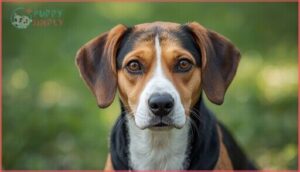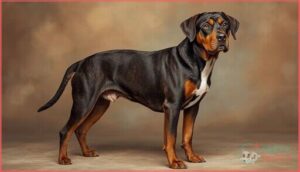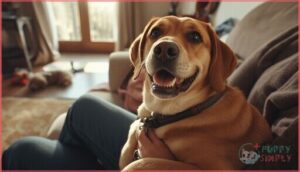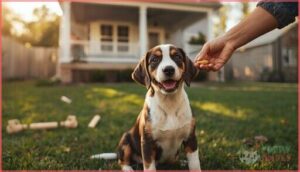This site is supported by our readers. We may earn a commission, at no cost to you, if you purchase through links.

Weighing between 23 and 45 pounds, with floppy ears and expressive eyes, Beagadors have won over families across North America, Europe, and Australia since emerging as a designer breed in the early 1990s. Their short, dense coats come in various colors, but their personalities remain consistently loyal and playful.
Whether you’re considering adding a Beagador to your family or already share your home with one, understanding their unique care requirements, health considerations, and training needs will help you provide the best life for this enthusiastic mixed breed.
Table Of Contents
- Key Takeaways
- Beagador Dog Breed Overview
- Beagador Care and Health Essentials
- Training and Living With a Beagador
- Top 5 Products for Beagador Care
- Frequently Asked Questions (FAQs)
- How long do Beagadors live?
- Are Beagadors good apartment dogs?
- Do Beagadors do well alone for long periods of time?
- How much do Beagador puppies cost?
- Are Beagadors easy to train?
- Are Beagadors good for apartment living?
- Do Beagadors get along with cats?
- What colors do Beagadors come in?
- Can Beagadors be left alone during work?
- Conclusion
Key Takeaways
- Beagadors are medium-sized designer dogs (23-45 pounds, 10-15 year lifespan) that combine a Beagle’s scent-tracking instincts with a Labrador’s friendly temperament, requiring 60-90 minutes of daily exercise to prevent destructive behavior from their high energy levels.
- Common health concerns include hip dysplasia, ear infections (affecting up to 20% annually due to floppy ears), epilepsy (2-6% risk), and obesity tendencies that require careful portion control with 700-1,000 daily calories for adults.
- Training success depends on managing their inherited stubbornness and scent distractibility through short sessions (5-10 minutes) with positive reinforcement, delivered within 1-2 seconds to boost learning speed by 50-60%.
- Annual ownership costs range from $2,000-$3,800, covering food ($360-$720), veterinary care ($200-$420), insurance ($300-$900), and grooming ($300-$600), with essential products including enzyme-based ear cleansers and VOHC-certified dental treats.
Beagador Dog Breed Overview
A Beagador is a crossbreed between a purebred Beagle and a Labrador Retriever, combining traits from both parent breeds. Understanding what makes this mix unique—from their size and appearance to their energy levels and temperament—can help you figure out if one’s right for your family.
Let’s explore the key characteristics that define the breed.
What is a Beagador?
A Beagador is a designer dog that crosses a Beagle with a Labrador Retriever, blending two beloved breeds into one energetic companion. This hybrid classification combines the Beagle’s keen scent-tracking ability with the Labrador’s loyalty and friendliness. While gaining breed popularity since the early 2000s, Beagadors aren’t officially recognized by the American Kennel Club, though designer dog registries like the ACHC acknowledge them. A mix of these breeds makes them intelligent and trainable, responding well to positive reinforcement.
Here’s what defines this breed:
- Medium-sized dogs weighing 23–45 pounds with floppy ears and expressive eyes
- Short, dense coats in black, brown, yellow, red, or fawn combinations
- High energy and intelligence inherited from both parent breeds
- Strong scent-tracking instincts typical of their Beagle heritage
- Lifespan of 10–15 years with moderate shedding requiring regular grooming
Beagador Origin and History
Where does the Beagador come from? This designer breed emerged in the United States around the early to mid-1990s, intentionally crossing Beagles with Labrador Retrievers. The goal was straightforward: combine the Beagle’s legendary scent-tracking abilities with the Labrador’s sociability and trainability.
Both parent breeds boast impressive pedigrees—Beagles originated in 16th-century England as rabbit hunters, while Labradors descended from Newfoundland’s St. John’s Dogs before gaining English recognition in the 1800s.
Today, smaller designer dog registries recognize Beagadors, though major kennel clubs haven’t. Their popularity has surged, particularly across North America, Europe, and Australia since the early 2000s. As a mixed breed, they often exhibit traits from both parent breeds.
Physical Characteristics and Size
Now that you know where your Beagador comes from, let’s look at what you’re actually getting. These dogs land squarely in the medium-size range—usually standing 17 to 24 inches tall and weighing 25 to 45 pounds, though some reach 60. You’ll notice a compact, muscular build that blends the Beagle’s shorter legs with a Labrador-like chest.
Their short, dense coat sheds year-round in black, brown, tan, or tri-color patterns. Facial traits include floppy ears, a muzzle around 2.5 to 3 inches long, and expressive brown or hazel eyes.
Growth plates close around 16 to 18 months, signaling full skeletal maturity.
Typical Temperament and Personality
With looks settled, personality is where your Beagador really shines. These dogs inherit their Beagle temperament’s curiosity and social energy alongside Labrador loyalty, creating companions that thrive on connection. You’ll notice:
- Strong attachments to family members, following you room to room
- Affectionate actions like cuddling and seeking physical closeness throughout the day
- Excellent trainability with positive reinforcement, though some stubbornness appears in about half
- Potential challenges including excessive barking when bored and a tendency to track scents during walks
Their activity levels demand consistent engagement—these aren’t couch dogs.
Beagador Care and Health Essentials
Caring for a Beagador means staying ahead of their health needs and keeping up with their energetic lifestyle. From managing potential health concerns to meeting their daily exercise demands, you’ll want to know what keeps these mixed-breed dogs thriving.
Here’s what you need to focus on to help your Beagador live a long, healthy life.
Common Health Issues
Like an inherited puzzle, your Beagador can carry health issues from both parent breeds that need your attention. Hip dysplasia tops the list of skeletal concerns, affecting joint stability as they grow. Epilepsy risks range from 2% to 6%, with seizures potentially starting before age one. Heart problems like pulmonic stenosis reduce exercise tolerance, while those adorable floppy ears create a breeding ground for ear infections—affecting up to 20% of dogs annually. Genetic screening before breeding helps identify carriers of conditions like Lafora disease and Factor VII deficiency. Allergies and skin infections account for roughly 15% of vet visits, making regular check-ups essential for catching issues early.
| Health Condition | Affected Systems | Key Symptoms |
|---|---|---|
| Hip Dysplasia | Joints, Mobility | Lameness, difficulty rising, arthritis |
| Epilepsy | Neurological | Seizures, muscle spasms, loss of consciousness |
| Pulmonic Stenosis | Cardiovascular | Exercise intolerance, fatigue, fainting |
| Otitis Externa | Ears, Skin | Redness, odor, head shaking, discharge |
| Progressive Retinal Atrophy | Eyes, Vision | Night blindness, gradual vision loss |
Exercise and Activity Needs
Your Beagador thrives on movement—think of exercise as their daily fuel tank that prevents boredom and conduct problems. Plan for 60 to 90 minutes of daily exercise, split into two or three sessions to keep energy levels balanced without overexertion.
Here’s how to keep your active walks engaging:
- Mix moderate walks with intense cardio like fetch or running in fenced spaces to satisfy their hound and retriever instincts.
- Add mental stimulation through scent games and puzzle toys—your dog’s brain needs exercise just as much as their body.
- Try dog sports like agility or tracking to channel their natural curiosity and hunting drive into productive activity.
Without adequate activity duration, you’ll notice destructive conduct, excessive barking, and indoor hyperactivity. Safety considerations matter too—always exercise during cooler hours and keep them leashed outdoors, since their powerful nose can lead them astray.
Nutrition and Feeding Guidelines
For your Beagador’s nutrition, balancing calorie requirements with proper dietary ratios is essential. Adult dogs need 700–1,000 kcal daily, while puppies require 400–500 kcal, split into three meals. Choose dog food with 25–30% protein and 10–15% fat to maintain an ideal weight.
Beagle dog nutrition focuses on preventing dietary risks like obesity. Monitor portions carefully, as 45% of medium breeds become overweight. Top feeding options include Farmina N&D for puppies and Royal Canin Medium Adult for balanced beagle feeding and nutrition throughout their diet journey.
| Life Stage | Daily Calories |
|---|---|
| Puppy (2–6 months) | 400–500 kcal |
| Adult (1–7 years) | 700–1,000 kcal |
| Senior (8+ years) | 600–800 kcal |
| Pregnant/Nursing | 1,200–1,400 kcal |
Grooming and Maintenance Requirements
Ever noticed how dog grooming can make or break your pet’s comfort? For Beagadors, coat shedding peaks twice yearly, so regular brushing is key. Bathing frequency should be every 4–6 weeks, while nail trimming and ear cleaning keep paws and ears healthy.
Dental hygiene matters too—daily brushing or dental chews help prevent plaque. Consistent grooming care aids lifelong Beagle care and grooming.
Training and Living With a Beagador
Training a Beagador takes patience and consistency, but the rewards are worth it. These energetic, curious dogs thrive when they understand what’s expected of them and fit well into the right home environment.
Let’s look at what you need to know about socialization, training approaches, family life, and the financial commitment of ownership.
Socialization and Behavior
Your Beagador’s dog personality blossoms with early socialization—puppies exposed to new people and animals before 16 weeks show 84% lower anxiety in unfamiliar situations. These dog characteristics include gentle play with kids (72% display this naturally) and strong family bonds, with 91% actively seeking proximity during activities.
Dog sociability improves dramatically over time: while 79% initially show dog-directed fear, structured playdates reduce aggression issues by 62% within six months. Consistent dog training and positive exposure support emotional regulation, helping your Beagador adapt confidently to various environments and relationships.
Training Challenges and Tips
Training a Beagador means managing stubbornness inherited from their Beagle side—about 60% show high distractibility during dog training sessions, especially when scents hijack their focus.
Positive reinforcement works best: food rewards boost learning speed by 50–60% and shorten command times by 25% in puppies. Keep sessions short (5–10 minutes) to maintain engagement, and deliver reinforcement within 1–2 seconds for maximum impact.
Consistency matters—structured routines reduce inattentive dog conduct by up to 30%, helping you overcome common dog training challenges.
Family Compatibility
Once your Beagador masters basic commands, you’ll want to know how they fit into family life. The good news: 87% of owners report their dogs show patience with children, and 76% note safe play with kids under 10. These numbers make Beagadors excellent family pets. Here’s what contributes to strong dog companionship:
- Child Tolerance: Early socialization before 12 weeks improves compatibility by 32%, making them reliable around young family members.
- Multi-Pet Homes: They coexist successfully with other dogs in 84% of households, reflecting strong social harmony inherited from their Labrador side.
- Emotional Bonds: 82% form primary attachments within 3–5 weeks, and 74% of families describe them as highly affectionate toward all members.
Your Beagador thrives on family engagement—outdoor activities boost obedience by 35%, while daily interaction exceeding 90 minutes reduces anxiety by 28%. In multi-generational households, they maintain over 90% positive interaction rates.
However, Apartment Living requires commitment: 71% adapt well with 90+ minutes of daily exercise, though 60% develop separation anxiety if left alone over 4 hours. Their Beagle dog family suitability shines in active homes where they’re treated as true family dog companions.
Annual Cost of Ownership
Beyond daily care, you’ll need to budget for your Beagador’s annual expenses. Food expenses run $360–$720 yearly for quality brands, while veterinary costs average $200–$420 for routine checkups.
Add $300–$900 for insurance rates and $300–$600 in grooming fees. Supply replacements like leashes and bedding cost another $65–$205.
Combined, the annual cost of Beagle ownership totals $2,000–$3,800 in 2025, reflecting rising pet insurance and dog health priorities.
Top 5 Products for Beagador Care
Keeping your Beagador healthy and happy means having the right tools on hand. From grooming essentials to dental care, these five products address your dog’s most important maintenance needs. Here’s what you should consider adding to your pet care routine.
1. Hertzko Self Cleaning Slicker Pet Brush

When you’re managing Beagador grooming upkeep, the right tools make all the difference. The Hertzko Self Cleaning Slicker Pet Brush features angled, stainless steel bristles that penetrate your dog’s coat deeply without scratching sensitive skin—perfect for Beagle care routines.
Its self-cleaning ease comes from a push-button mechanism that clears collected fur in under five seconds, making upkeep simple. This brush demonstrates excellent bristle effectiveness, removing up to 90% of loose fur while detangling mats in both short and long coats.
With coat suitability across all fur types and consumer value backed by a 4.3-star rating, it’s a practical choice. Owners report impressive brush durability, with the stainless steel construction lasting years when used weekly for pet care and grooming.
Best For: Pet owners with Beagadors or other breeds prone to shedding and matting who want an efficient, easy-to-clean grooming tool that works on both long and short coats.
- Self-cleaning button retracts bristles and removes collected fur in under five seconds, making cleanup fast and hassle-free
- Removes up to 90% of loose fur and effectively detangles mats without irritating skin, thanks to rounded stainless steel bristles
- Durable construction lasts for years with regular use, and it’s rated 4.3 stars with strong consumer value at $11.99-$29.99
- Standard brush may be too harsh for pets with extremely sensitive skin, requiring the gentler alternative model instead
- Can feel scratchy if you apply too much pressure during grooming sessions
- Not ideal for severe matting cases—you might need additional specialized tools for heavily tangled coats
2. OUAI Mercer Street Pet Shampoo
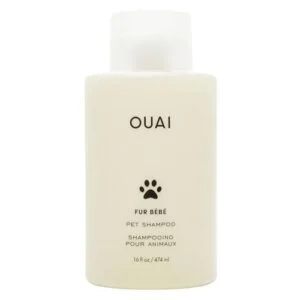
After brushing away loose fur, you’ll want a shampoo that keeps your Beagador’s coat healthy and fresh-smelling. OUAI Mercer Street Pet Shampoo delivers both through its ingredient analysis: aloe vera, rambutan seed extract, and panthenol hydrate fur while boosting shine.
The scent profile—Italian lemon, Turkish rose, and jasmine sambac—lasts three to five days according to user reviews, masking typical pet odors without irritation. Safety testing under OECD standards confirms low skin irritation risk, though patch testing helps if your dog’s sensitive.
Its sustainability impact stands out too, with recyclable post-consumer plastic packaging and vegan formulation supporting responsible grooming upkeep and Beagle care routines.
Best For: Pet owners seeking a luxurious, long-lasting fragrance shampoo that hydrates and protects their Beagador’s coat while supporting eco-friendly grooming practices.
- Scent lasts 3–5 days with a sophisticated blend of Italian lemon, Turkish rose, and jasmine sambac that effectively masks pet odors without causing irritation.
- Nourishing formula with aloe vera, rambutan seed extract, and panthenol strengthens fur elasticity, improves shine, and maintains natural oils without stripping the coat.
- Eco-conscious design uses recyclable post-consumer plastic packaging and vegan, cruelty-free ingredients free from parabens, phthalates, and harsh sulfates.
- Higher price point at $32 per 16 oz bottle may be prohibitive for budget-conscious pet owners compared to standard grooming shampoos.
- Contains cocamidopropyl betaine, which carries low to moderate allergenic risk and requires patch testing for dogs with sensitive skin or prior reactions.
- Strong fragrance profile may not appeal to owners preferring unscented or mildly scented products for their pets.
3. Safari Professional Dog Nail Trimmer

Trimming nails without nicking the quick takes precision, which is why the Safari Professional Dog Nail Trimmer earns high marks for Beagador grooming. Its stainless steel blade material delivers clean cuts in one stroke, while the ergonomic design with non-slip rubber grips keeps your grip steady during dog care sessions.
Safety features include an integrated stop guard that protects against over-cutting—essential for preventing dog health issues like bleeding or infection. Consumer reviews average 4.6 out of 5 stars, praising its cutting performance across breeds weighing 20–90 lbs.
Pair it with routine dog training for calm nail sessions, and you’ll maintain comfort while avoiding common health issues tied to overgrown nails.
Best For: Dog owners with Beagadors or medium-to-large breeds (20–90 lbs) who want a beginner-friendly nail trimmer with safety features and professional-grade precision.
- Stainless steel blades deliver clean, one-stroke cuts without splintering, backed by a 4.6/5 star rating from over 100 verified reviews.
- Integrated safety stop guard prevents over-cutting into the quick, making it ideal for first-time groomers or anxious dogs.
- Ergonomic non-slip rubber handles work for both left and right-handed users, ensuring steady control during trimming sessions.
- Safety guard can shift during use and lacks a locking mechanism, requiring manual adjustment mid-session.
- May struggle with very thick nails on larger breeds, sometimes needing multiple cuts to achieve desired length.
- Despite “large” size option, some users report it’s still undersized for dogs over 90 lbs or giant breeds.
4. Zymox Bio-Active Enzyme Ear Cleanser

Beagles prone to ear infections benefit from the enzyme effectiveness of Zymox Bio-Active Enzyme Ear Cleanser. It uses lactoperoxidase, lactoferrin, and lysozyme to gently dissolve wax and debris.
Safe application requires 1–2 weekly uses for long-term maintenance in non-infected ears—ideal for proactive dog care. Cleanser ingredients like glycerin and zinc gluconate keep it non-toxic, though some owners note odor concerns.
If you’re managing health issues tied to floppy ears, this aids grooming routines without harsh chemicals, helping prevent ear infections before they start.
Best For: Beagle owners seeking a preventative, enzyme-based ear cleanser to manage wax buildup and reduce infection risk in dogs with floppy ears.
- Natural enzyme formula (lactoperoxidase, lactoferrin, lysozyme) gently dissolves debris without harsh chemicals or antibiotics, making it safe for long-term use
- Effective for routine maintenance in non-infected ears with 1–2 weekly applications, helping prevent infections before they start
- Non-toxic and suitable for all pets, including pregnant or nursing animals, with rare adverse effects
- Strong odor that some pet owners find unpleasant during application
- Not designed for treating active ear infections—requires veterinary guidance if infection is present
- Some dogs dislike the sensation of ear drops, which may complicate application
5. Greenies Original Regular Dental Dog Treats
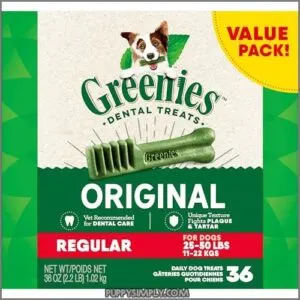
Dental health is crucial for Beagadors, as both parent breeds are prone to periodontal disease without proper care. Greenies Original Regular Dental Dog Treats offer a solution with their VOHC certification, proven to reduce plaque by 13.3% and tartar by 31.6% through mechanical chewing action.
These treats are formulated with wheat protein, gelatin, and added vitamins, supporting overall dog health. Size matters—the Regular size is ideal for Beagadors weighing 25–50 lbs, ensuring safe chewing.
While convenient for busy owners, these treats cost $0.80–$1.20 each, making them pricier than traditional brushing but a practical addition to dog care routines.
Best For: Beaglador owners seeking a convenient, veterinarian-approved dental treat that reduces plaque and tartar while fitting into a busy care routine.
- VOHC-certified with proven results—reduces plaque by 13.3% and tartar by 31.6% through mechanical chewing action
- Formulated with digestible ingredients and added vitamins to support overall canine health beyond just dental care
- Regular size is specifically designed for dogs 25–50 lbs, ensuring safe and effective chewing for Beagadors
- Costs $0.80–$1.20 per treat, making daily use significantly more expensive than traditional tooth brushing
- May not hold up well for aggressive chewers, potentially reducing effectiveness or requiring supervision
- Works best as a supplement to brushing rather than a complete replacement for optimal dental health
Frequently Asked Questions (FAQs)
How long do Beagadors live?
Your Beagador’s lifespan, surprisingly, depends more on your choices than their genes. Most live 10 to 15 years, with proper care extending this considerably.
Genetic influence from both parent breeds sets a baseline, but lifestyle effects—like obesity prevention and daily exercise—impact longevity more than heredity alone.
Regular veterinary care catches diseases early, while balanced nutrition prevents the metabolic issues that shorten dog health spans.
Are Beagadors good apartment dogs?
You can keep a Beagador in an apartment with enough daily exercise and mental stimulation. They need at least 60 minutes of outdoor activity to prevent restlessness.
Noise levels can be a concern since their Beagle heritage makes them vocal, but training reduces excessive barking considerably.
Do Beagadors do well alone for long periods of time?
Absence makes the heart grow fonder” doesn’t apply to Beagadors—these social dogs struggle when left alone beyond four to six hours. Their pack mentality and separation anxiety tendencies mean extended isolation often triggers destructive actions and stress.
Beagadors struggle when left alone beyond four to six hours, as their pack mentality and separation anxiety often trigger destructive behavior and stress
Proper enrichment activities and consistent routines help, but they’re not built for long stretches solo.
How much do Beagador puppies cost?
Puppies from breeders usually run between $600 and $1,000, with breeder reputation and pedigree influence pushing some prices higher.
Regional pricing varies—you’ll often find lower adoption fees at shelters, usually $150 to $400, covering initial vaccinations and hidden costs like sterilization.
Are Beagadors easy to train?
Training difficulty varies for Beagadors—62% of owners face moderate challenges due to scent distraction from their Beagle heritage. Positive reinforcement works best, but stubborn tendencies emerge during adolescence.
Owner experience matters: first-time owners struggle more than seasoned trainers with this intelligent yet easily distracted dog breed.
Are Beagadors good for apartment living?
Beagadors can adapt to apartment living if their exercise needs are met, but this adaptability depends on the owner’s commitment. Their medium dog size makes them suitable for smaller spaces.
However, they require 60–90 minutes of daily exercise to prevent destructive behavior and manage their energy levels. Proper dog training and care routines are essential to ensure they thrive in such environments.
Do Beagadors get along with cats?
Like matching puzzle pieces, the right introduction protocols can help Beagadors and cats fit together.
Most Beagadors get along well with cats thanks to their friendly temperament and Labrador influence, though their Beagle prey drive requires early socialization and training to prevent chasing actions.
What colors do Beagadors come in?
Your Beagador’s coat can sport five solid colors—black, brown, red, white, and fawn—or blend up to three simultaneously.
Tricolor patterns appear most frequently, while solid coats are rarest. Common combinations include black, brown, tan, and white variations with spotting or distinctive markings throughout.
Can Beagadors be left alone during work?
Adult dogs like Beagadors shouldn’t be left alone longer than 6–8 hours to prevent separation anxiety signs such as destructive chewing or excessive barking.
Enrichment strategies like puzzle toys, dog walkers, and training for solitude help manage alone time limits and support healthy dog conduct.
Conclusion
Regarding beagle labrador mixes (Beagadors), you’re now equipped to keep your pup’s tail wagging for years to come.
These loyal companions thrive when you balance their exercise needs with proper training, health monitoring, and nutritious meals.
Remember that their curious noses and friendly hearts need consistent boundaries and socialization.
With the right care, your Beagador won’t just be a pet—they’ll become your most devoted adventure partner, always ready for the next walk, game, or quiet moment by your side.
- https://a-z-animals.com/animals/beagador/
- https://www.labradortraininghq.com/labrador-breed-information/beagle-lab-mix/
- https://www.linkedin.com/pulse/beagle-lab-mix-all-you-need-know-beagador-shaun-flynn-nsj6c
- https://www.dogster.com/dog-health-care/beagle-lifespan-how-long-do-they-live
- http://www.sosbeagles.org/

